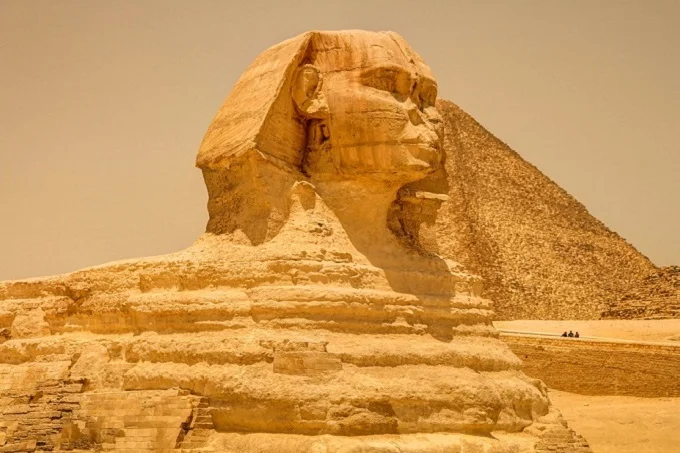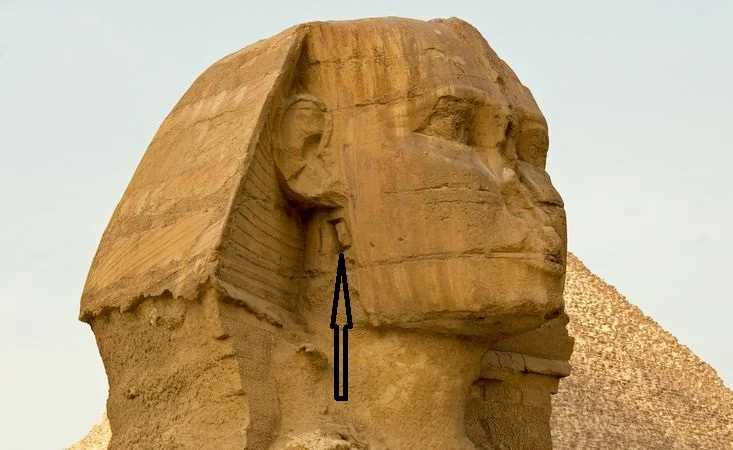Who took off the headdress of the Sphinx?

It turns out that the sphinx has a “birth canal cover”. There is an assumption that previously, the sphinx had a hat, like the statue in the photo.

The Egyptian government’s engineers fixed the sphinx’s head in 1931. In 1926, erosion caused part of its headpiece to break off, cutting badly into its neck. The insertion of a concrete collar between the headpiece and the neck, giving a changed profile, was the problematic repair. The stone foundation and raw granite body were extensively renovated in the 1980s, then refurbished in the 1990s.
However, if you look from above, it turns out that the head of the sphinx is too flat, just right for a headdress, and the opening is like a tongue-and-groove system.
But perhaps it was covering something more important: In 1979, the condition of the sphinx became quite bad. Urgent steps had to be taken to save the monument – literally to keep it from losing its head. The previous inept restoration by the Egyptians themselves, who had used ordinary cement, had only worsened the quality of the head of the statue over the years.
During the first phase of the restoration work, an American-Egyptian fellah group named Mohamed Abd al-Mawgood Fayed, who as a child in 1926 worked to extract the sphinx from the sand under the direction of the French engineer Emile Barazi, told the restoration supervisors about the existence of a small hole in the neck of the sphinx, which he had forgotten about and only recently remembered.

According to this old man, it was possible to penetrate into the statue through the hole. Struck by such an unusual revelation, the members of the American Research Center for Egyptology, led by Zahi Hawass and Mark Lehner, without a moment’s hesitation, grabbed flashlights and, forgetting for a time about the head of the sphinx, made their way into it.
What the archaeologists discovered there did not resemble the description of the galleries in any of the legends of the ancient and medieval chronicles. A tunnel well was discovered, formed by very narrow caves – no more than a meter wide, with a total length of 9 meters.
One of the wells leads upwards inside the torso of the statue, following the curves of all its four paws, while the other descends vertically and bumps into the rock. Both grottoes form an angle of 90 degrees.

Their walls are unpolished and look no more finished than in Castilian wine cellars. After a tedious search for traces of workmanship, it was discovered that the work here was carried out from the top to down, and at the top, they even found a semblance of steps, rather holes in the wall, which had been dug to facilitate the descent into the tunnel.
Now there are no obstacles to exploring other parts of the sphinx, in which it is already known that there are voids.
The American geophysicist Thomas Dobecki had already carried out a series of joint studies in the early 1990s with the Boston University geologist Robert Schoch, author of the latest controversial theory, which dates the sphinx to between the eighth and sixth millennia BC.
During this work, “anomalies and cavities in the mother rock between the statue’s legs and on the sides of the sphinx” were discovered. The most remarkable of the four newly discovered cavities is the one measuring 9 meters by 12 meters at the base and 5 meters deep. The size and very structure of this new chamber completely exclude the idea that it is a natural cave. This means that there are secret rooms in the insides of the sphinx.
What is hidden in them? Maybe the archives of ancient civilizations, such as the mythical Atlantis?




